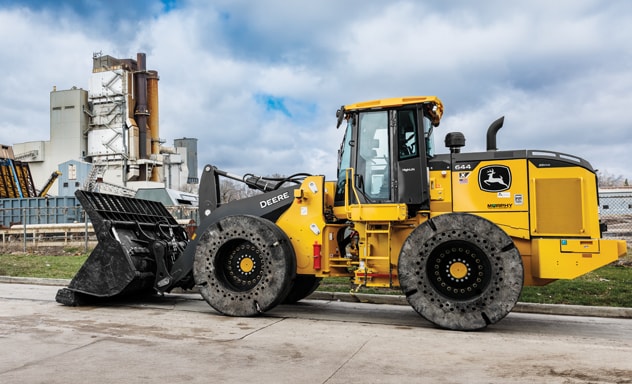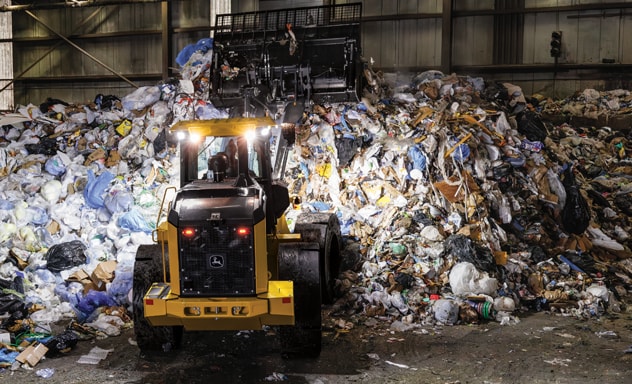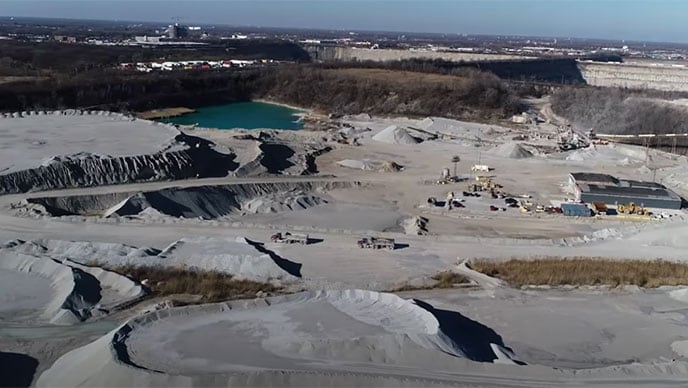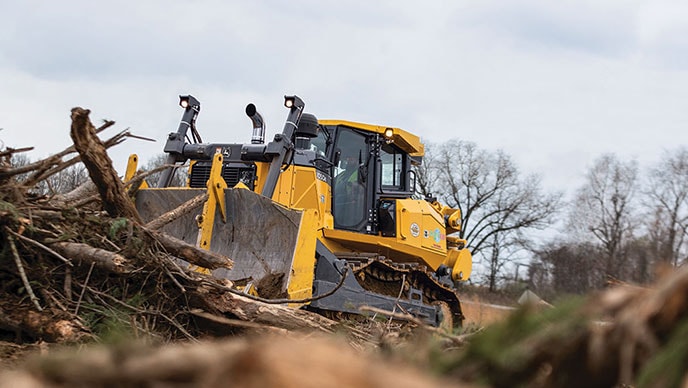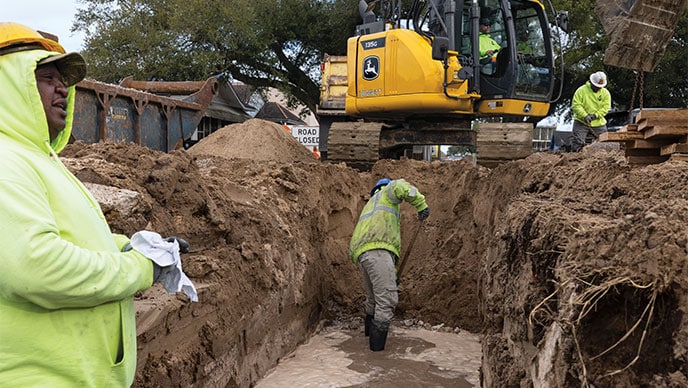Ames Waste Management | John Deere Construction
Spring 2025
Fuel Sustainability
Iowa Plant Turns Waste Into Power
![]() 5 MIN READ
5 MIN READ
Transforming Municipal Waste Into Productive Power Is All in a Day's Work for the Crew at This Midwestern Resource Recovery Plant
Just a few minutes after sunrise on a chilly spring morning, most residents of Ames, Iowa, are still waking up and easing into their day.
Traffic is light on East Lincoln Way, the four-lane thoroughfare leading to the Arnold O. Chantland Resource Recovery Plant. Surrounding businesses have not yet flipped on their lights or opened their doors.
Within the walls of the resource recovery plant, however, the air is already buzzing with activity.
Garbage trucks enter and exit the structure, sending loads of material tumbling down to the floor below. The low, steady hum from a series of conveyors reverberates throughout the bustling facility.
The noise is rivaled only by the pervasive odor. This is, after all, the building that accepts the waste collected from dumpsters and curbsides through the entire community.
"You get used to the smell," laughs Mark Peebler, assistant superintendent and a 21-year veteran at the plant.
The day-to-day grind may not be glamorous. The end result, however, is downright awe-inspiring.
The Arnold O. Chantland Resource Recovery Plant opened in 1975, becoming the first-ever municipal owned- and- operated waste-to-energy facility in the nation. The plant collects refuse from commercial and residential properties throughout Story County, sorts out recyclable metals, and burns a portion of the remaining waste to fuel the city's nearby power plant. It's a process that generates enough energy to power 4,600 homes each year.
"Generally speaking, most communities are sending about 70 percent of their waste out to landfills," Peebler explains. "With this center, we are doing the opposite. We're keeping 70 percent of waste out of landfills. There is a tremendous sense of accomplishment that comes with that."

"This environment is an extreme one. We are looking for machines that can consistently be pushed to the full extent of their capabilities."
Always in Motion
Before the county's waste can be transformed into a source of power, an intricate process must unfold.
It all begins with Aaron Wirth, who has amassed more than a decade of experience as the resource recovery plant's primary heavy equipment operator.
When waste trucks enter the plant and deliver loads of refuse, Wirth is tasked with moving the immense volume of material, discarding the larger objects, and preparing the rest of the refuse to enter the vast system that sorts through it. Without him, everything comes to a halt.
"It's always different and forever changing," says Wirth. "But I don't mind the challenge. I have the team and the equipment I need to handle it."
Today Wirth is spending his shift in a John Deere 644 X-Tier Wheel Loader.
"We put this machine through a lot," he says, glancing upward at a 25-foot tall pile of refuse he amassed over the course of the day. "The lift capacity and the power are incredible."
Wirth's work sets the rest of the complex process into motion. The pieces of refuse are placed within an elaborate, winding conveyer system where the metals are extracted by magnets and sent to a scrap dealer for recycling. The rest of the waste is sent through a series of shredders. The majority of the material is sent via an underground pipe to a nearby power plant, where it is burned and utilized as refuse-derived fuel. For Wirth, a lifelong Ames resident, being a part of the operation is a major source of pride.
"So many people cannot believe what we do in this small building in Ames, Iowa," he says with a wide smile.
Demanding More
Fleet Support Manager Rich Iverson is the man responsible for making sure operators like Wirth have the machines they need to get their work done.
Iverson started with the City of Ames 15 years ago and now oversees a fleet of more than 300 machines. The equipment utilized at the resource recovery plant represent a small but essential part of that broader fleet.
"This environment is an extreme one," he says as he watches the 644 X-Tier pushing into a large pile. "We are looking for machines that can consistently be pushed to the full extent of their capabilities."
Iverson's purchase decisions are also influenced by the big-picture goals of the city for which he works.
In addition to the 644 X-Tier, the resource recovery plant utilizes a pair of 644K Wheel Loaders. While these machines are consistently pushed to the max, Iverson takes comfort in the support system that exists.
"Our dealer, Murphy Tractor & Equipment Co., has been a great partner for us," he says. "We're certainly not their biggest customer by any means, but they treat us as if we were."

"So many people cannot believe what we do in this small building in Ames, Iowa."
A Brighter Future
Within the Arnold O. Chantland Resource Recovery Plant, there are certain moments when it feels like the past, present, and future are converging all at once. Well over a decade since his retirement, the namesake of the facility still makes the occasional appearance there.
"Arnold likes to stop in and say hello, bring a few donuts, and see how things are going," Wirth says. "I think it's fun for him to see how things are still moving forward."
Even as it celebrates its 50th anniversary, the resource recovery plant still feels like it's ahead of the curve. Peebler says Ames remains the only city in Iowa that is burning refuse to generate power, and he estimates fewer than 80 facilities nationwide have embraced the practice.
"We've had a lot of visitors from other counties, other states, even other countries come to tour our facility just to see how we're doing this," Peebler says. "Others can take what we're doing and bring that knowledge back with them."
It's another group of visitors that leaves the strongest impression on Peebler, however. Multiple times a year, local students visit the plant to learn about the innovation taking place in their own backyard.
"When those kids come through here, they're amazed at how much material is thrown away every day," Peebler says, his eyes growing wider. "But I think they're even more surprised that we do something with it — that we power our community. That's a cool thing for them to learn."
The Power of Reducing Waste

Fifty years ago, the Arnold O. Chantland Resource Recovery Plant opened in 1975.

The Ames plant was the first municipally owned and operated waste-to-energy facility in the nation.

The plant generates energy to power 4,600 homes each year.

The facility saved 80-plus acres of Iowa farmland from becoming a landfill.
The City of Ames is serviced by Murphy Tractor & Equipment Co., Des Moines, Iowa.
Related Articles
Think readers would dig your story?
You could be featured in an upcoming edition of The Dirt. To be considered, just tell us a bit about yourself and your story idea by filling out this form.

